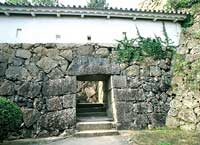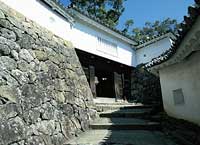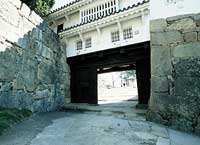Kids Web Japan
Web Japan > Kids Web Japan > Travel > A Tour of Japanese Castles > Himeji Castle
Travel
A Tour of Japanese Castles
Himeji Castle (Hyogo Prefecture)
 The ground of Himeji Castle are like maze. (Himeji City)
The ground of Himeji Castle are like maze. (Himeji City)
Himeji Castle was built with the finest techniques available at the time. It is known as "White Egret Castle" because its beautiful white walls look like a soaring white egret. In 1993 the castle became one of the first Japanese buildings to be chosen as a UNESCO World Heritage site. The castle in its present form was completed in 1609 after eight years of construction. The main tower miraculously survived both World War II and the Great Hanshin-Awaji Earthquake of 1995, which struck another part of Hyogo Prefecture. The gates, passageways, and other parts of the buildings bear such unusual names as "I no mon" and "Ni no yagura." The names come from the traditional Japanese alphabet.



 Some of the gates and holes in the walls for firing weapons inside Himeji Castle (Himeji City)
Some of the gates and holes in the walls for firing weapons inside Himeji Castle (Himeji City)
After arriving at the castle, walk toward the tower. Pass through the gates, including one with a low ceiling that is difficult to go through and another that looks like part of the stone wall and is easy to miss if you are in a hurry, and follow a winding path uphill. At one time, the castle supposedly had 84 gates, but today just 21 remain. If you look hard, you will discover a variety of openings in the walls. It feels as if rocks or arrows may come raining down on you at any time. Try drawing the different openings and showing them to a friend.
It takes about an hour and a half to walk around the castle just one time. The grounds of the castle are ideal for bird-watching, since swans, seagulls, and other species inhabit the area. The Shinkansen (Bullet Train) provides an outstanding view of the castle, so if you are traveling through western Japan but don't have time to get off at Himeji, try to get a window seat on the mountain side.
Access
Forty minutes by Shinkansen from Osaka, and a 15-minute walk from Himeji Station.